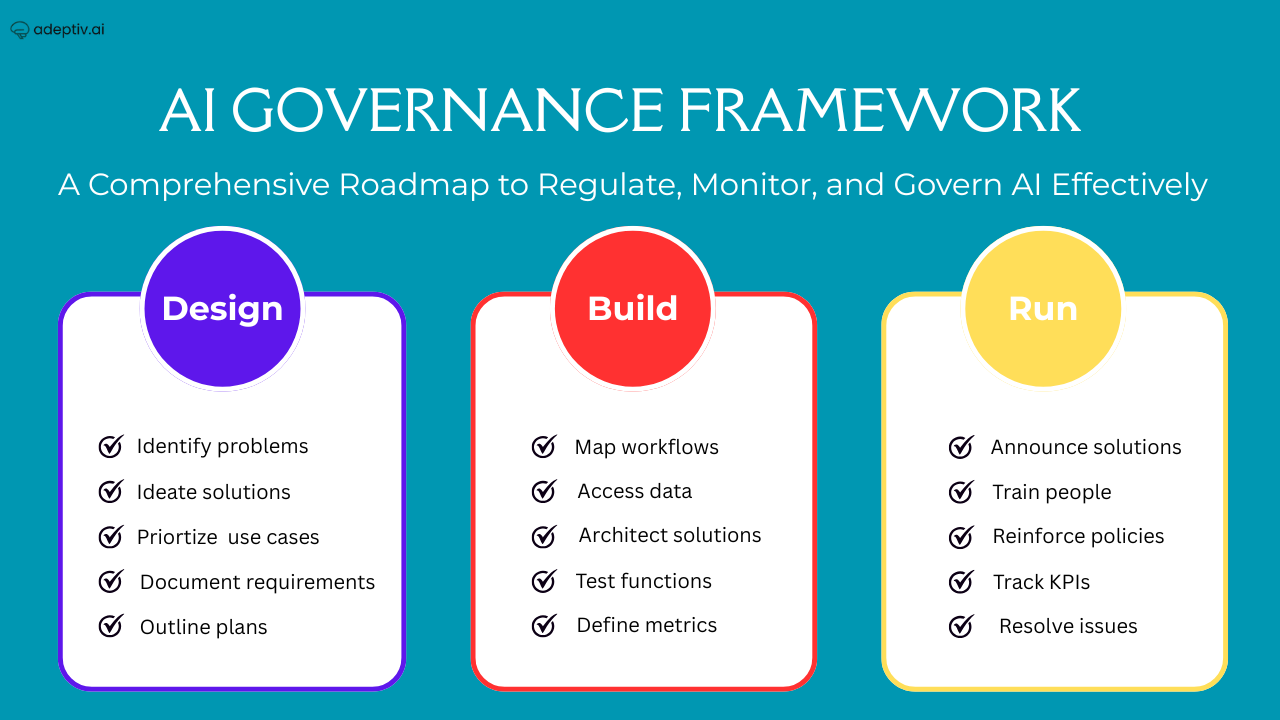At a Glance
- What data governance means in an AI-powered business environment.
- Why governance is critical for data accuracy, security, and ethical AI.
- Key components of a robust data governance framework.
- Practical strategies for adoption and scaling.
- How to align governance with AI lifecycle and agent-based systems.
Introduction: Why Data Governance Matters Today
In an era where organizations increasingly rely on AI systems to automate decisions, personalize services, forecast risk, and optimize operations, the true currency of competitive advantage is data. But data itself does not create value — trusted, governed, high-quality data does. As AI architectures become more complex and interconnected, the challenge is no longer just storing and processing data, but ensuring that data remains accurate, consistent, compliant, and ethically sourced throughout its lifecycle.
Without strong governance, even the most advanced AI systems can produce harmful, biased, or misleading outcomes. Poor-quality data leads to poor predictions, which in turn affects business strategy, customer trust, and regulatory standing. The stakes are high: companies today face increasing regulatory scrutiny under GDPR, CCPA, HIPAA, and emerging global AI acts — meaning governance is no longer optional. It is a foundational requirement for AI maturity and enterprise credibility.
What is Data Governance?
Data governance refers to the system of policies, processes, standards, roles, and technologies used to ensure that data within an organization is managed responsibly. It governs how data is collected, stored, accessed, shared, used, and eventually retired.
Unlike traditional data management, which focuses on technical handling, data governance is strategic. It aligns data practices with:
- Business goals
- Ethical principles
- Regulatory compliance
- Security frameworks
- AI lifecycle needs
A powerful way to understand governance is:
“It ensures the right data is available to the right people at the right time, in the right condition, and under the right permissions.”
For AI systems, governance ensures that:
- Training data sets are unbiased and representative
- Data lineage is clearly traceable
- Models operate on reliable, verified inputs
- Outcomes remain explainable and auditable
Without governance, AI decisions become opaque, risky, and unaccountable.
Strategic Benefits of Data Governance in AI-Driven Organizations
| Benefit | Description |
| Improved Data Quality | Ensures data used for AI training is clean, complete, and reliable. |
| Stronger Security & Compliance | Protects sensitive data while meeting regulatory obligations. |
| Operational Efficiency | Reduces redundant work and accelerates data-driven decision-making. |
| Greater Transparency & Trust | Builds confidence among regulators, partners, and users. |
| Scalable AI Adoption | Creates a repeatable governance baseline for future AI systems. |
“Good AI depends on good data, and good data depends on good governance.”
Key Elements of a Strong Data Governance Program
1. Data Stewardship and Ownership
Assign accountable data stewards and data owners to maintain oversight, accuracy, and policy alignment.
This ensures responsibility is not diffused or unclear across teams.
2. Data Quality and Standardization
Implement rules ensuring data is:
- Accurate
- Consistent
- Complete
- Timely
- Techniques like data profiling and anomaly detection are critical here.
3. Security, Privacy, and Compliance
Establish role-based access controls (RBAC), encryption protocols, anonymization pipelines, and policy documentation that map to GDPR, HIPAA, CCPA, ISO 42001, and NIST AI RMF frameworks.
4. Data Access and Sharing Controls
Ensure the right level of access without restricting innovation.
Example: Provide anonymized datasets to business teams while retaining raw sensitive datasets for data scientists.
5. Lifecycle Management and Data Lineage
Track how data evolves across systems, transformations, and model training.
This enables AI decisions to remain explainable, auditable, and reversible.
Driving Adoption: The Carrot vs. Stick Model
| Approach | How it Works | Example Use Case |
| Carrot (Incentive-Based) | Show teams how governance improves insights, efficiency, and trust. | Tech companies boosting AI accuracy through quality data dashboards. |
| Stick (Compliance-Based) | Enforce policies through audits and mandatory procedures. | Finance & healthcare organizations requiring strict regulatory adherence. |
Most organizations succeed by using a hybrid approach depending on team maturity and risk profile.
Data Governance and the Rise of AI Agents
As enterprises adopt AI agents — autonomous systems that interpret information, make decisions, and take actions — governance becomes even more crucial.
Types of AI Agents
| Agent Type | Description | Governance Requirement |
| Reactive Agents | Respond to stimuli without memory. | Ensure input data is accurate and contextually valid. |
| Limited Memory Agents | Learn from recent data and interactions. | Track data lineage and update governance checks continuously. |
| Goal-Based Agents | Optimize toward defined objectives. | Transparent explanation of optimization criteria and outcomes. |
| Learning Agents | Self-improve over time. | Continuous auditing to prevent drift, bias, or unintended behaviors. |
Proper governance ensures AI agents act accountably, safely, and predictably.
Common Challenges and How to Overcome Them
| Challenge | Solution Strategy |
| Resistance to Change | Conduct cultural readiness training and demonstrate value repeatedly. |
| Resource Constraints | Start with high-impact data domains and scale gradually. |
| Data Silos | Introduce shared taxonomies and centralized governance councils. |
| Complexity of AI Data Pipelines | Automate monitoring and lineage tracking. |
Conclusion: The Future of Governance is Proactive + Responsible
Data governance is not merely a compliance requirement — it is the foundational layer that determines whether AI systems are trusted, ethical, scalable, and strategically valuable. Organizations that invest in governance today are building future-proof AI ecosystems that can adapt to shifting regulations, customer expectations, and technological evolution.
At Adeptiv AI, we help organizations turn governance into operational advantage — integrating policy, technology, and ethical guardrails into the AI lifecycle so businesses can innovate with confidence.
FAQs
1. How does data governance impact AI model accuracy?
High-quality data ensures models learn from correct and representative patterns, improving reliability and performance.
2. Is data governance only for large enterprises?
No. Even startups benefit from governance to avoid technical debt and compliance risks as they scale.
3. How does governance support regulatory compliance?
Governance maps data practices to legal requirements, helping organizations avoid violations and fines.
4. What tools support data governance in AI workflows?
Metadata catalogs, lineage trackers, access control platforms, and model monitoring systems are commonly used.
5. How often should governance frameworks be updated?
Continuously — especially as new AI models, data streams, or regulations emerge.
6. Can AI itself assist in data governance?
Yes — AI-driven quality detection and anomaly monitoring are now standard in modern governance systems.



